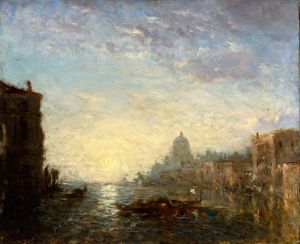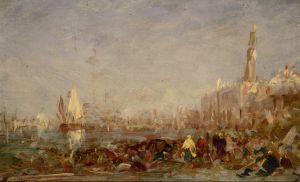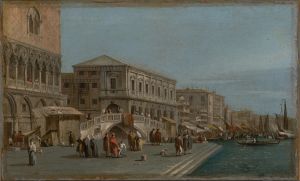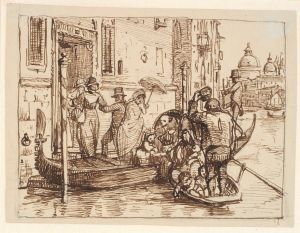
Allegory of Venice
A hand-painted replica of Giovanni Battista Tiepolo’s masterpiece Allegory of Venice, meticulously crafted by professional artists to capture the true essence of the original. Each piece is created with museum-quality canvas and rare mineral pigments, carefully painted by experienced artists with delicate brushstrokes and rich, layered colors to perfectly recreate the texture of the original artwork. Unlike machine-printed reproductions, this hand-painted version brings the painting to life, infused with the artist’s emotions and skill in every stroke. Whether for personal collection or home decoration, it instantly elevates the artistic atmosphere of any space.
Giovanni Battista Tiepolo, an Italian painter of the 18th century, is renowned for his grand and imaginative frescoes and paintings that capture the spirit of the Rococo period. Among his many works, "Allegory of Venice" stands out as a significant piece that reflects both his artistic prowess and the cultural context of his time.
"Allegory of Venice" is a painting that embodies the grandeur and the political power of the Venetian Republic. Tiepolo, known for his ability to blend reality with the fantastical, uses allegory to convey the virtues and the esteemed status of Venice. The painting is a celebration of the city, often personified as a majestic and powerful female figure, symbolizing Venice's wealth, influence, and cultural significance during the 18th century.
In this work, Tiepolo employs his characteristic style, marked by dynamic compositions, vibrant colors, and dramatic use of light and shadow. The allegorical figure of Venice is typically depicted in a regal manner, surrounded by symbols of prosperity and power, such as the lion of Saint Mark, which is the emblem of Venice. The use of allegory allows Tiepolo to infuse the painting with layers of meaning, making it not just a visual representation but also a narrative of Venice's identity and its role in the world.
Tiepolo's mastery in fresco painting is evident in "Allegory of Venice," as he creates a sense of depth and movement that draws the viewer into the scene. His ability to depict figures with grace and elegance, combined with his skillful use of perspective, gives the painting a sense of grandeur and majesty that is fitting for the subject matter.
The painting reflects the political and cultural climate of Venice during Tiepolo's time. The 18th century was a period of both prosperity and challenge for the Venetian Republic. While Venice was a major center of commerce and art, it was also facing political pressures from other European powers. Tiepolo's work can be seen as a response to these dynamics, celebrating the city's enduring legacy and its cultural achievements.
"Allegory of Venice" is housed in the Ca' Rezzonico, a museum in Venice dedicated to 18th-century Venetian art. The museum itself is a testament to the rich artistic heritage of the city, and Tiepolo's painting is a highlight of its collection. Visitors to the museum can appreciate the painting not only for its artistic beauty but also for its historical significance as a reflection of Venice's identity during a pivotal time in its history.
In summary, Giovanni Battista Tiepolo's "Allegory of Venice" is a masterful work that captures the essence of Venice through allegory and artistic brilliance. It stands as a testament to Tiepolo's skill as a painter and his ability to convey complex themes through his art. The painting remains an important piece of Venice's cultural heritage, offering insight into the city's past and its enduring influence in the world of art.


















